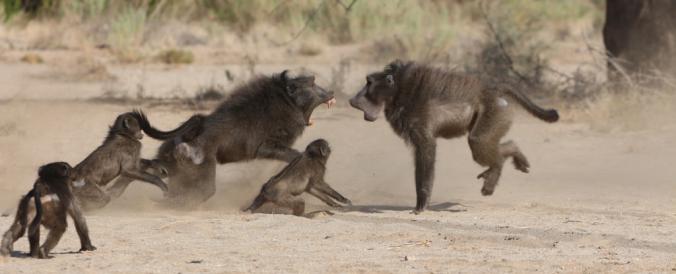
Family life is fascinating–whether the family involved is made up of humans, monkeys, or hippos. Recently I’ve been exploring the complexities of mammal family life, and I’ve been thinking about what this research can and cannot tell us about our own experiences in families.
Last week in the New York Times, I wrote my column about some intriguing research on what happens when monkey mothers nurse their babies. Their milk doesn’t just deliver nutrients. It also has messages–different levels of hormones–that influence how babies develop, both physically and psychologically.
This week I’ve taken a darker turn. My column is about why male mammals sometimes kill unrelated infants.
It may sound strange, but the “why” of infanticide has a lot in common with the “why” of nursing’s effects on babies. In both cases, scientists have found evidence that these are adaptive responses. In the case of nursing, the babies appear to be reading the messages in their milk to judge the condition of their mother. They’re then adjusting their development to make the best use of her resources. In the case of infanticide, males that compete with other males to be with females can get more of an opportunity to have babies of their own by killing unrelated babies first.
Both stories are fascinating, and not just for their immediate results. We can’t help but wonder what scientific research of other mammals may tell us about ourselves. Yet the insights are not straightforward, and so we have to be on our guard not to draw simplistic conclusions.
We don’t yet know how much of an influence hormones in milk have on human development, for example. Monkeys and humans both nurse, but they nurse in very different ways (human mothers don’t keep their babies nursing constantly, for example). And human babies are influenced by many other factors as they develop.
As for mammal infanticide, it may be tempting to see it as an explanation for human child abuse. But you can’t draw a simple parallel between, say, the death of a human child in a chaotic home where there’s been lots of drug abuse and the death of a baby monkey that’s been systematically stalked for days by an adult male.
Nor do these stories give us easy answers about what is right or wrong in human family life. To try to make that leap is to commit a moralistic fallacy. I’ve had a lot of experience watching people make that fallacy. That’s one of the hazards of reporting on evolution.
I first wrote about infanticide 18 years ago. I was working at Discover, and I had taken a trip to Sumatra not long before, where I had spent some time with scientists at a forest reserve. Some of them were following monkeys, observing their family life. They told me how males sometimes killed babies. There were no killings when I was there, which isn’t surprising given that they happen quickly and relatively rarely. But even as I watched the monkeys leap through the high canopy, busy with their own complicated social lives, I kept wondering about why they would turn homicidal.
When I got back home, I spoke to Sarah Hrdy, an anthropologist who developed the argument that infanticide is part of a reproductive strategy in the 1970s. I talked to her critics, and I also talked to scientists who found evidence for infanticide in other species. You can read the feature I ended up putting together here. (Here’s a site where Hrdy keeps a lot of papers.)
Shortly after the article came out, the creationists came after me. Specifically, the president of the Institute of Creation Research at the time, John D. Morris. He published a piece called, “Will Infanticide Follow Abortion As Acceptable Behavior?”
He ended it this way:
The discussion reviewed her [Hrdy’s] theories and others who followed, but the most chilling aspect was the possible use of this animal behavior as a model for human behavior. The article’s author, Dr. Carl Zimmer, stopped short of advocating human infanticide, but clearly the issue was raised and not discarded. Those who today practice infanticide were discussed without condemnation. A comparison to the disparity in frequency of child-killing between biological fathers and step-fathers was made. Nowhere was the practice of infanticide condemned, and, of course, no mention was made of it as a sin.
The article did speculate on the various reasons why langurs (and other animals) choose to kill their young, and comparisons were made to human situations. The reader is left to shudder at the thought of the possibilities, but be numbed to its consequences, by greater familiarity with it.
One only has to look at Hitler’s Germany to recognize similarities. Atrocities escalated until unthinkable things were attempted. It is my conviction that the trends in this country are the same. A wholesale turnover of politicians, media elite, and education theorists would help to stem the tide. The groundwork has already been laid, the damage may have already been done. We will soon reap even more awful fruits of evolutionary thinking, unless we go “Back to Genesis.”
Morris was wrong in all sorts of ways (beginning with the fact that I’m not “Dr.” Zimmer). But his screed was valuable as an example of how easily people can–intentionally or not–make a fallacious leap from nature’s “is” to human “oughts.” In order to make our own moral judgments–about breast-feeding, about protecting children from abuse–we need to understand how evolution has shaped us. That’s no simple task, and when it comes to judging the right thing to do for children, it’s just the beginning.